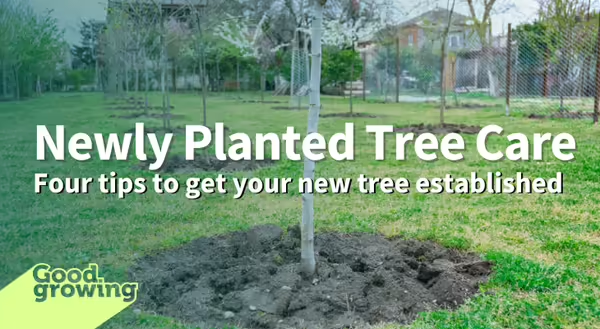
How do you take care of a newly planted tree?
Lots of trees get planted in April, at least in Illinois. What follows is a ‘will they, won’t they…survive?’ In multiple instances, I’ve come across a tree that gets planted and maybe watered once to a handful of times that year. What most people don’t realize is that it can take up to three years for a newly planted tree to establish its roots in the native soil of your yard.
How do we care for our newly planted trees to make sure we get them through that initial three-year establishment period? Let’s look at four practices to get your tree growing on the right root.
Watering
You may have guessed this from the beginning: watering is critical to a tree's survival, and poor watering (too much or too little) is the number one reason for establishment failure. When planting, thoroughly water the root ball and planting hole. As time passes, be sure to provide supplemental water to the tree if rain is inconsistent. Container-grown trees are sold growing in an artificial potting mix that will dry out faster than bare-root or balled-and-burlapped trees.
The question that is often asked, and one you may be wondering yourself, is how often do you need to water a newly planted tree? The answer to this question is not as straightforward as you may want to hear. The quantity of supplemental water required will be influenced by soil structure, seasonal temperatures, how exposed the tree is to sun and wind, and natural rainfall amounts. Provide supplemental water when necessary to keep the root ball and surrounding soil from drying out. Continue during the first three years of establishment. With recent spans of drought that have plagued western Illinois these recent years, watering trees has become a higher priority on my landscape to-do list. All trees, established or newly planted, will benefit from supplemental water during hot, dry periods.
Mulch
Wait a second! As stated above, we need to “provide supplemental water when necessary to keep the root ball and surrounding soil from drying out.” For three years! If that sounds like a daunting task, which would have you in the yard every day holding a hose at the base of your tree, we have a method to help insulate the soil and regulate moisture levels. The answer is mulch! Ideally, a woodchip mulch that has large and irregular-sized chunks. A chipped-up tree works well and offers a use for arborist woodchips. Large irregular-shaped woodchips do not knit together like shredded wood mulch fibers often do, forming a water-repelling shell.
Staking
If there is one practice we can skip most of the time, it would be staking newly planted trees. It is very often unneeded except for very top-heavy trees, in very high wind locations, or to keep lawn mowers and vandals away. And if you do end up staking your tree, remove the staking material within a few months and up to a year from installation.
When a tree is staked, it is important to allow the tree to move in the wind. By encountering a wind load and swaying, a tree builds up the woody fibers in the base of the trunk to help it resist wind load, making it stronger.
Deer protection
It is almost a guarantee, at least in my area, that a newly planted tree is going to encounter a deer. Either being nibbled to the ground or used as a scratching post for antler rubbing, deer can quickly kill or stunt young trees. The best way to protect newly planted trees is with some type of physical barrier to keep the deer from getting near the tree. Caging a tree with wire mesh or plastic snow fencing will keep the deer off your trees. Support the fencing with a couple of posts driven into the ground so the fencing doesn’t damage the tree.
Trees are a long-term investment for your property and the environment. Make proper watering a priority, utilize mulch to maintain soil moisture, and protect your trees from those stomachs with legs, also known as deer!
Good Growing Tip of the Week: The only pruning necessary on newly planted trees is to remove dead, diseased, or broken branches. Once the tree is established, you can begin pruning to promote a strong structure.
Sign up for our emails! Want to get notified when new Good Growing posts are available? SIGN ME UP
Give us feedback! How helpful was this information (click one): Very helpful | Somewhat helpful | Not very helpful
MEET THE AUTHOR
Chris Enroth is a horticulture educator with University of Illinois Extension, serving Henderson, McDonough, Knox, and Warren counties since 2012. Chris provides horticulture programming with an emphasis on the home gardener, landscape maintenance personnel, and commercial landscapers. Additional responsibilities include coordinating local county Master Gardener and Master Naturalist volunteers - providing their training, continuing education, advanced training, seasonal events, and organizing community outreach programs for horticulture and conservation assistance/education. In his spare time, Chris enjoys the outdoors, lounging in the garden among the flowers (weeds to most).